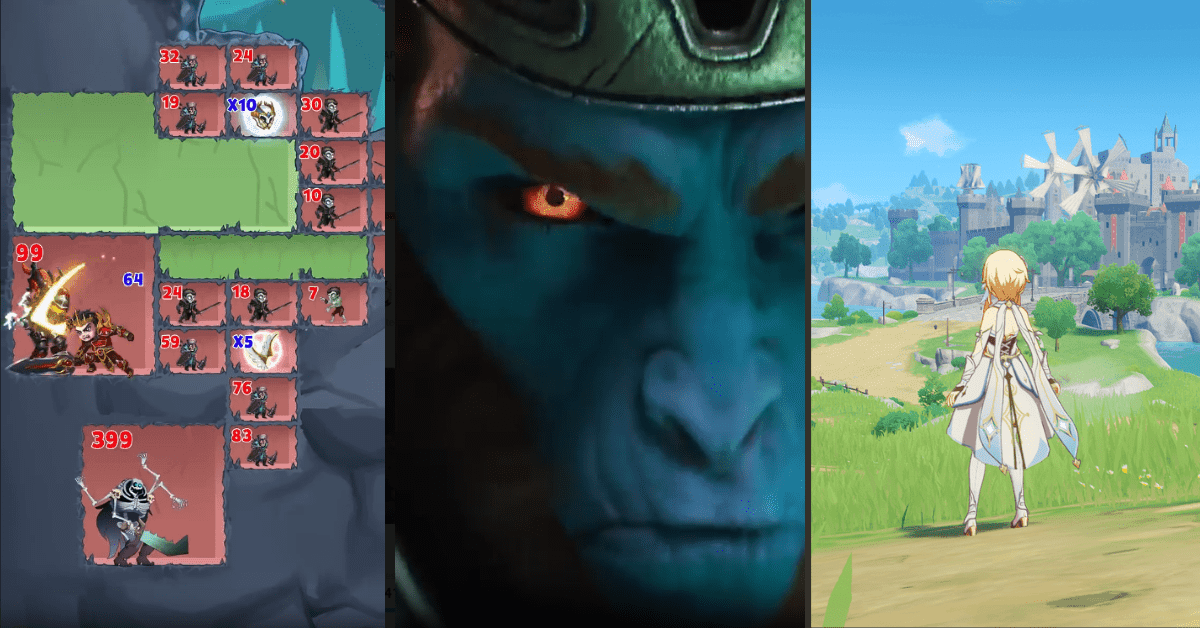The world of RPG advertising is as dynamic and immersive as the games it promotes. Whether you’re looking to scale your user base or simply learn about the intricacies of this lucrative market, this guide has something for you.
We’ll explore the current state of the RPG market, share invaluable statistics and tips for user acquisition, and even break down the latest trends in ad creatives.
So, if you want to make your role-playing game the next big hit, you’ve come to the right place. Let’s dive in.
The State of the RPG Market
Role-playing games, commonly known as RPGs, involve players taking on the roles of characters in a fictional setting. These games are defined by character progression, story-driven quests, and interactive environments.
Within the broad realm of RPGs, you’ll find various subgenres, including MMORPGs, team battlers, idle RPGs, puzzle RPGs, roguelike games, open-world RPGs, and even MOBA games.
In terms of market trends, the RPG sector is thriving.
According to Statista, it’s projected to reach a market volume of a whopping $98.72 billion by 2027, with the lion’s share of this revenue coming from China.
How does the revenue break down?
About two-thirds come from in-app purchases and the remaining one-third from in-app ads. Remarkably, only a minuscule percentage comes from paid apps.
One stat that stands out is the average revenue per user (ARPU) for RPGs – around $7.22. That’s substantially higher than what you’d find in casual games, for example.
From an acquisition standpoint, RPGs boast cost-effective metrics, with a CPI of $0.60. That’s significantly lower than other mid-core genres like shooter games for example, with an average $7.46 CPI.
However, it’s worth noting that the Day 7 Return On Ad Spend (D7 ROAS) is also a bit lower, standing at 1.7%, according to data from Liftoff.

Top RPGs on Mobile in 2023
To give you a snapshot of what’s currently dominating the charts, here are lists of top RPGs by two key metrics: player spend and downloads. These insights are courtesy of AppMagic and are pivotal for anyone dabbling in RPG advertising.
Top RPGs by Player Spend
- Honor of Kings by Tencent
- Genshin Impact by miHoYo
- Honkai Star Rail by miHoYo
- モンスターストライク by XFLAG
- Fate/Grand Order by Aniplex
- Goddess of Victory: Nikke by Tencent
- 逆水寒 by NetEase
- 리니지M by NCSOFT
- Dragon Ball Z Dokkan Battle by Bandai Namco
- Puzzle & Dragons by GungHo

Top RPGs by Downloads
- Mobile Legends Bang Bang by Moontoon
- Genshin Impact by miHoYo
- Honkai Star Rail by miHoYo
- Hero Wars: Alliance by Nexters
- Honor of Kings by Tencent
- Garena RoV by Garena
- Legend of Slime: Idle RPG War by LoadComplete
- Pokémon Unite by The Pokémon Company
- Dragon Ball Legends by Bandai Namco
- One Piece Bounty Rush by Bandai Namco
RPG Advertising Tips for Acquiring Users
Let’s dive into the core of the matter – how to effectively advertise your RPG to acquire users. Knowing the state of the market is essential, but applying that knowledge through effective advertising strategies is what truly counts.
So, let’s get into some proven tips for RPG advertising that could make all the difference for your game.
1. Set Correct Goals and KPIs
When it comes to RPG advertising, the first step is setting the right goals and key performance indicators (KPIs). Understand that each game genre has its nuances, making the approach to advertising a casual game different from a mid-core game like an RPG.
Being data-driven is vital.
For instance, as I mentioned previously, the cost-per-install (CPI) for RPGs is generally lower compared to other mid-core genres like strategy or shooter games. However, it’s higher than what you’d see for casual games. The return on ad spend (ROAS) follows a similar trend – it’s higher than it is for casual games but not as high as some other mid-core genres.
This implies a more nuanced investment strategy.
You’ll initially invest more compared to casual games, but the returns are also higher. However, patience is key; the payback period for RPGs is typically longer.
That’s why RPG advertising campaigns often target acquiring quality players who will stick around for the long haul and make in-app purchases, rather than focusing on sheer quantity.

2. Understand What Appeals to RPG Players
Before you jump into RPG advertising, a deep understanding of your target audience is crucial.
Let’s start with demographics.
According to Facebook Gaming research, the majority of RPG players are younger men. For example, in the U.S., 62% of players are male and 65% are aged 18–34. Similar stats hold true for the UK and Japan.
Behavioral traits are also noteworthy.
RPG players typically engage for more than 30 minutes per session and often identify as gamers, unlike their casual gaming counterparts. They are motivated by stress relief, immersion in other worlds or characters, and competitive elements.
When it comes to advertising, a large percentage are open to trying a new game if the ad catches their eye. Specifically, 42% of U.S. RPG players want to see the main gameplay in ads. Close behind, 40% value the characters or story, and 30% are interested in character or universe progression.
These preferences are generally consistent across other markets.

3. Produce Attention-Grabbing Ad Creatives
When it comes to advertising role-playing mobile games, video ads are the best way to go about it. It is hands down the most effective way to acquire more users for your mobile RPG and get it to the top charts.
However, creating video ads that convert users is an art in and of itself. There’s a lot that goes into it.
If you’re new to creating attention-grabbing video ads, here are a couple of tips to get you started.
First, take a look at your competitors’ video ads – it’s one of the best ways to learn what works and what doesn’t. (I analyze video ad trends from top mobile RPGs later in the article, so make sure you stick around).
The next step is to identify the key features of your game and your USP. Think about what will make users download your game – is it the unique characters and worlds? Perhaps it’s the captivating storyline or engaging gameplay?
Whatever it may be, make sure to highlight it in your video ad. The purpose of a video ad is to showcase how incredibly good your game is and what makes it better than all other mobile RPGs.
Finally, you need to create multiple variations of your video ads – just 2 or 3 won’t cut it. Then you test them and analyze which ones got you the most users. Once you weed out the video ads that don’t convert and create even more variations of the ones that do work, you’ll have a tried and true recipe for creating effective video ads.
However, if you’re struggling with creating video ads that actually convert users, you might want to think about outsourcing it to an experienced marketing agency.
Advertise Your Role-Playing Game in Other Mobile Games
Another strategy you can use for RPG advertising is to advertise your role-playing game in other mobile games. Since many publishers use in-game ads as their monetization method, this is a great opportunity to advertise your game.
Here’s how it works.
The publishers of games you want to advertise in are looking to fill their ad space with relevant ads in order to maximize their ad revenue. You’re placing ads for your game inside other similar games, thus reaching an audience that’s highly likely to be interested in it.
However, you should know that targeting such a specific audience is not cheap. Once you go very narrow with your target audience, the user acquisition tends to become very pricey. So keep that in mind.
Another strategy is to cross-promote your role-playing game. If you have several titles published, you can advertise your mobile RPG inside your other mobile games.
Once again, you’ll be putting your role-playing game in front of users who are already playing your other games and are very likely to be interested in it.
RPG Advertising: Ad Creative Trends & Examples from Top Games
Now that we’ve covered the importance of setting the right goals and understanding your audience, let’s delve even more into the creative aspect of RPG advertising. Crafting compelling ad creatives is crucial for grabbing attention and encouraging downloads.
In this section, we’ll explore current trends and offer real-world examples from top-performing RPGs that have nailed their advertising strategies.
Showcasing Unique Game Worlds
One of the main appeals of RPGs for players is the chance to immerse themselves in captivating worlds and engaging characters. It’s no surprise, then, that many successful RPG advertising campaigns place a strong emphasis on showcasing these elements.
Simple yet impactful videos often take the spotlight, focusing on the game’s environment and world.
Take note of top role-playing games like Souls by Habby, Dragonheir: Silent Gods by Nuverse Games, and Genshin Impact. They all make effective use of this advertising trend, letting the game world itself be the star of their promotional efforts.

Focusing on Game Characters
Another main aspect of RPGs that resonates with players is the focus on characters. Naturally, this aspect often takes center stage in RPG advertising.
Players are keen to know a character’s backstory, combat capabilities, stats, weapon arsenal, and how it works with other characters. Incorporating these facets into your ads can significantly boost their appeal.
Consider the approach taken by Marvel Strike Force.
Many of their ads delve into showcasing a single character, detailing its story, stats, and how it fits within a team setup.
Longform Videos with Impactful Storylines
While short-form video ads under 30 seconds are generally the industry norm, there are compelling reasons to venture into longer formats. Sometimes, a game’s narrative or features require more screen time for effective storytelling.
A striking example is a 1-minute 30-second ad from Genshin Impact.
This ad interweaves real-life stock footage with gameplay scenes – for instance, a person parachuting segues into a character gliding through the game’s skies.
The ad aims to evoke strong emotions, focusing on themes like community, friendship, and freedom. Genshin Impact has even pushed the envelope further, rolling out ads that stretch nearly 10 minutes.

Mini-Game Ads
Though RPGs might seem like an unlikely candidate for mini-game ads, they’ve actually adopted this trend rather successfully. The rationale is straightforward: mini-game ads can significantly lower CPIs and reach a wider audience.
However, the approach is more nuanced compared to the basic pin-pulling puzzles you might commonly see.
Hero Wars serves as a prime example of mastering this strategy. Their ads often showcase tower puzzles, challenging players to maneuver through different tower sections while defeating enemies. Interestingly, these ads were so popular that Hero Wars even incorporated these mini-games into actual gameplay, further blurring the lines between advertising and the gaming experience.

User-Generated Content
When it comes to mobile game advertising, user-generated content has taken on a slightly different meaning. Typically, game studios hire creators who simulate the experience of actual players.
These creators produce low-budget, authentic-looking videos where they discuss game features or even perform funny sketches related to the game.
Take Genshin Impact, for instance.
One of their ads features a gamer who records himself playing the game and introduces Fontaine, a new region in Genshin Impact. In this ad, the gamer explores new game mechanics like diving, offering prospective players an insider’s look into what’s coming up.

Big Budget Animated Ads
When it comes to pulling out all the stops, certain RPGs don’t hold back. Top-performing games like Raid: Shadow Legends and MOBA titles like Mobile Legends Bang Bang have invested in high-production-value animated ads. These ads could easily pass for scenes from big-budget animated films.
The advantage?
These cinematic videos can present gripping storylines and showcase thrilling action sequences. Interestingly, these ads often forego actual gameplay footage altogether. Yet, they have a unique ability to capture viewer attention in a way that makes them highly effective in RPG advertising.
Final Thoughts on RPG Advertising
So, we’ve gone through the various facets of RPG advertising, from setting the right KPIs to understanding player behavior and the evolving trends in ad creatives.
As you’ve seen, advertising RPGs involves a blend of art and science – each campaign demands its unique touch to resonate with your target players. Remember, what works for one genre may not work for RPGs.
(Data source: AppMagic)







Comments